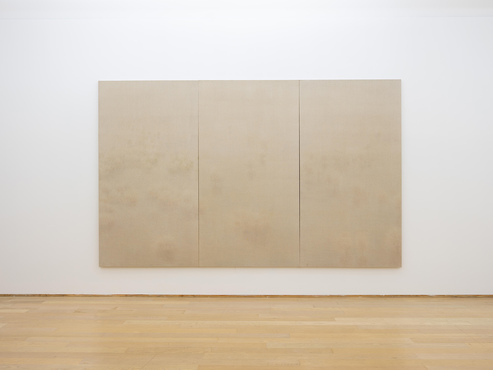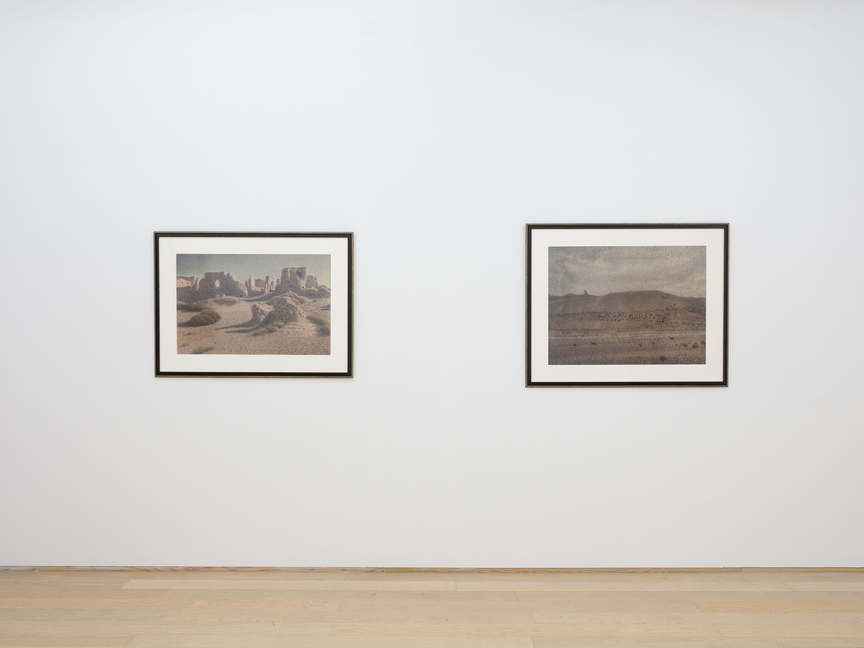-
From Current Issue
-
- Editor’s Letter Fire in the Heart
- Reviews I Gusti Ayu Kadek Murniasih
- Reviews 11th Seoul Mediacity Biennale: “One Escape at a Time”
- Dispatch Networked China
- One on One Monira Al Qadiri on Yukio Mishima
- Essays The rise of independent art spaces in pandemic-era Shanghai
- Features Tuan Andrew Nguyen
- Table of Contents
- Web Exclusives
- Archive
- Subscribe

R
E
V N
E
X
T
Installation view of QIU SHIHUA’s Lake, 1994, oil on canvas, 92 × 151 cm, at “Dawn Light,” Hanart TZ Gallery, Hong Kong, 2018. Photo by Kitmin Lee. All images courtesy the artist and Hanart TZ Gallery.
Trained in oil and Chinese ink painting at the Xi’an Academy of Fine Arts, Qiu Shihua started his artistic career by producing painted film posters during the Cultural Revolution. It was in the late 1980s that he began to create what he is now widely recognized for—void paintings: images that look blank from afar but that in fact depict trees, mountains and clouds in faintly colored pigments or gesso. Qiu’s solo show, “Dawn Light,” presented at Hong Kong’s Hanart TZ Gallery, highlighted 11 of the artist’s paintings from this iconic body of work.
Fittingly, all of the canvases were mounted on the wall without glass coverings to avoid reflections or glare from the gallery’s lights distracting viewers from the nuances of Qiu’s barely perceptible compositions. The lofty ceilings in the capacious gallery complemented his works in that his mysterious landscapes seemed to blend and expand onto the gallery’s white walls, and yet viewers were given substantial room to breathe. The painting that benefitted most from this spacious setup was the gigantic Landscape 1999.4 (1999), which consists of three four-meter-high panels. Viewers need to spend extended periods of time with Qiu’s delicate works, and Landscape 1999.4 was no different. Gradually, as visitors’ eyes grew accustomed to the canvas’s subtly variegated white and gray hues, nebulous shadows gave shape to immense mountains, in turn partly veiled by clouds and mist. Even with these forms emerging from the picture plane, however, light and airiness was abound in the expansive triptych.
Interestingly, besides the beige canvases, the gallery also exhibited two of Qiu’s earlier pieces from his 1990s series “Silk Road,” which detail desert scenes from northwestern China. For instance, Dunhuang Caves (1990) shows a stretch of grottoes built into the side of a sandy hill, and is painted in earthy tones. The caves and plants are made up of dots densely layered over each other, recalling a pointillist technique, such that the overall image is hazy—an effect compounded by the felt paper on which the paints are applied. At first glance, the “Silk Road” works appeared out-of-place in comparison with the rest of Qiu’s later pieces due to their heavier coloring and recognizable subjects. Nonetheless, it was this juxtaposition that triggered reflections on Qiu’s various approaches toward visibility. The “Silk Road” paintings hint at the beginning of the artist’s pursuit to come as close to dissolving an image as possible through low-contrast palettes, which culminated in the white paintings. As such, they were a valuable inclusion in the show.
Yet interpretations of Qiu’s artistic practice should not be limited to a process of subtraction, as many might assume when they see his nearly empty paintings. In actuality, the beige canvases emerge from intensely accumulated layers of paint. Each time a new layer is added, the artist modifies the thickness of the coat and the tint in the white pigment to achieve textural interest and a subtle diversity in color. As the title of the exhibition suggests, what Qiu has always been trying to capture is the wide spectrum of light and color that humans can sense at dawn when the first gleam of sunshine brightens the world. His works stimulate viewers to observe in stillness, to sink themselves into dense layers of paints. The vitality that is cloaked under the thick whiteness in Qiu’s landscapes then become light glistening through the morning haze.
Dennis Mao is an editorial intern of ArtAsiaPacific.
Qiu Shihua’s “Dawn Light” is on view at Hanart TZ Gallery, Hong Kong, until October 6, 2018.
To read more of ArtAsiaPacific’s articles, visit our Digital Library.





